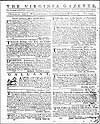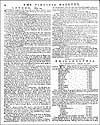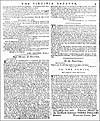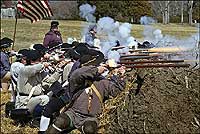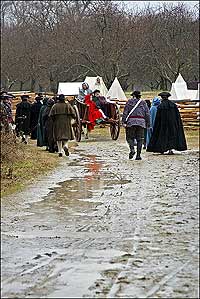A Common American Soldier
by Christopher Geist
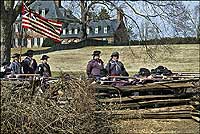
A typical band of patriot soldiers, the Second Virginia Regiment bested Governor Dunmore and his troops in the Battle of Great Bridge in 1775, here re-created at Carter's Grove for the Colonial Williamsburg electronic field trip Soldier of Liberty.
Before the nineteenth century was more than a couple of decades old, certainly by the fiftieth anniversary of 1776, the United States had come to regard the veterans of its revolution with a sort of wistful romanticism. An emerging American popular culture developed a vision of the common soldier of that war which more or less reflects ours: citizen-soldiers—farmers, laborers, men of the middling sort, young and old—minutemen who picked up their muskets and fell in with their militia units to defend home and community from invading Redcoats. The enemy driven from the field, the fighters returned to the plow, or anvil, or hearth, alert for the next threat. As the years drew on, and more and more of the old soldiers mustered for the march to the grave, the nation's veneration of them only advanced. A sort of pantheonic mythology grew.
In 1837, for example, Ralph Waldo Emerson's elegy "Concord Hymn" celebrated the "embattled farmers" who "fired the shot heard round the world." In a speech a year later, young Abraham Lincoln spoke of "the generation just gone to rest," and the War for Independence. In part, he said:
At the close of that struggle, nearly every adult male had been a participator in some of its scenes. The consequence was, that of those scenes, in the form of a husband, a father, a son or a brother, a living history was to be found in every family—a history bearing the indubitable testimonies of its own authenticity, in the limbs mangled, in the scars of wounds received, in the midst of the very scenes related—a history, too, that could be read and understood alike by all, the wise and the ignorant, the learned and the unlearned. But those histories are gone. They can be read no more forever. They were a fortress of strength; but what invading foemen could never do the silent artillery of time has done; the levelling of its walls. They are gone....Who, exactly, were these embodiments of history?
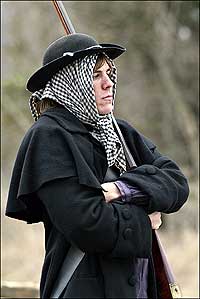
In Soldier of Liberty, Russell Fenton is a boyish recruit, just as were many of the men of '76. Some served the entire war.
The colonies required militia service, generally, of males between sixteen and sixty, excepting clergy, college students, slaves, and, often, free blacks. In Virginia, service by Catholics was forbidden. The militiamen came from the civilian ranks of tailors, mechanics, small farmers, bootmakers, smiths, gentry, common laborers, shopkeepers, clerks, lawyers, tutors, carpenters. The units roughly mirrored the laity of free white male colonial society.
In theory, the militia system provided a deep reservoir of men ready to be put under arms, and, indeed, during the Revolution the number of men who served in militia units far outnumbered that in the Continental Army. Militia was sometimes used effectively by Continental officers to reinforce and support regular forces, or to hold fortifications and fieldworks. Pitched battles were fought solely by militia at such engagements as the Battle of King's Mountain in 1780, but they were exceptions. Sometimes, as the next year at Cowpens, militia units were arrayed in advance of Continentals, taking the initial British attack, firing a volley, and falling back. The regulars moved forward to surprise the enemy with a body of more effective regular troops. Most militias saw action within their home regions, being called to duty as the contending armies moved from theater to theater. Using the militia as a benchmark, Lincoln's statement that "nearly every adult male had been a participator" in the Revolution seems accurate.
But should the occasional participant—the militiaman—be viewed as the most typical, the most reliable American soldier of the conflict?
Probably not.
As important as the militiamen were, and though they were the most numerous American participants in the war, Continental forces were the backbone of the struggle almost from the beginning. The Second Continental Congress established the American Continental Army by an act of June 14, 1775, authorizing ten companies of riflemen from Pennsylvania, Maryland, and Virginia, and appointing George Washington commander in chief. The act also drew into the regular forces the militia surrounding Boston and fortifying the New York City area.
By 1776, enlistments in the regular force were set for three years instead of the single year of service originally specified, and in 1777 Washington, who wanted well-seasoned troops for the heart of his army, persuaded Congress to permit duration-of-the-war enlistments.
Washington was never enamored of the militia, once writing that "to place any dependence upon militia is assuredly resting upon a broken staff." Toward the end of summer in 1775, he noticed that farmers serving in the militia vacated the field of battle as harvest time approached. Militia units dissolved when hostilities moved away from their home locales. Discipline was all but nonexistent in many units because most elected their officers and command authority was thus compromised. Of the New England militia, Washington wrote, "Their officers generally speaking are the most indifferent kind of people I ever saw." Militia privates ignored commands issued by officers of the Regular Army, which disturbed Washington.
Moreover, their training was at best rudimentary. Nathanael Greene, one of Washington's brigadiers, said that militiamen had "all the tender feelings of domestic life ...not sufficiently fortified with natural courage to stand the shocking scenes of war." Private Joseph Plumb Martin of the Continental Army, whose memoir is one of the best known and most quoted of the conflict, wrote that though "on particular occasions" militia might serve well, "they would not have endured the sufferings the army did ...and when the hardships of fatigue, starvation, cold and nakedness ...begun to seize upon them ...they would have instantly quitted the service in disgust." Only a standing professional force whose private soldiers enlisted for the long term could hope to prevail against an enemy army which arguably was the finest, most disciplined, and effective in the world.
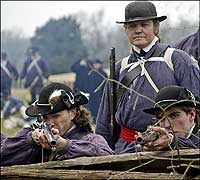
Officer portrayed by Bill Rose oversees Paul Masterson, left, and Russell Fenton, young recruits facing the world's strongest army. Many in the patriot cause were fifteen or sixteen years old, and casualties were far higher than they would be in the American Civil War.
What sort of soldier stood in the Continental Army? Historians have pieced together a composite portrait, using, among other evidence, muster rolls, and veterans' pension applications posted in the 1820s and 1830s.
Like many soldiers in America's conflicts, the common Continental was, on average, quite young. One historian found that in nine New Jersey towns nearly 75 percent of boys who were fifteen and sixteen at the onset of hostilities served in the army or the militia. Martin was fifteen when he enlisted, artilleryman Jeremiah Levering entered the service at twelve or thirteen, and hundreds more under the legal age of sixteen served in all services. Thousands more were under twenty.
Many, including Martin, must have been drawn, at least initially, by the adventure of it all. His guardians prevented his first attempt to enlist at age fourteen, and he was envious of his young associates who had marched off to fight. "By and by," he wrote, "they will come swaggering back, thought I, and tell me of their exploits, all their 'hair-breadth 'scapes.' ...O, that was too much to be borne with by me." He enlisted the next year. Many a wide-eyed youth must have been easy pickings for recruiting sergeants.
Most of those pickings also were poor and drawn "from the disrespected and dispossessed ranks of society," according to historian Holly A. Mayer, and they "had little or no property or marketable skill." Pay was poor and often delayed or deferred, discipline was harsh, food meager and sometimes rotten, and clothing and shelter often insufficient. But for some men the army was a better and more dependable way of life.
John Adams doubted that most men among the gainfully employed and rising middle class could be persuaded to enlist for protracted service when they could remain at home with "a better living, more comfortable lodgings, more than double the wages, in safety, not exposed to the sickness of camp." In Virginia, contemporary observers recommended that regular forces be recruited from among those "who could best be spared, and will be most serviceable," in short, "those Lazy fellows who lurk about and are pests to Society." Historian John Shy writes of the common Revolutionary soldier that:
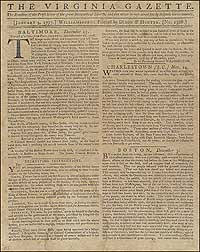
General George Washington's recruiting instructions appeared in the Virginia Gazette. After discharge, soldiers were to receive 100 acres of land. And if patriotism and land were not enough, he granted them "all the plunder they shall take from the enemy."
As a group, they were poorer, more marginal, less well anchored in society. Perhaps we should not be surprised; it is easy to imagine men like these actually being attracted by the relative affluence, comfort, security, prestige, and even the chance for satisfying human relationships offered by the Continental Army.As the war dragged on, Congress imposed recruiting quotas on the states, leaving each to fill its as best it could. Enlistment bounties and conscription became common. Bounties enticed some of society's more marginal sorts to join. Conscription coerced the youthful and powerless to serve. Men of some means who were drafted were permitted to pay a substitute to serve in their steads. Many an indentured servant and apprentice entered the Continental Army as substitutes for their masters. Draftees persuaded constables to "sell them" vagrants and other petty offenders to serve in their places. A few British deserters and prisoners of war found their way into the Continental Army as substitutes.
Historian Charles Royster discovered that some recruits were sent off through a combination of the strategies:
People bought recruits from entrepreneurs. Enterprising businessmen could pay a willing recruit the official bounty and then offer him to draftees as a substitute. The high bidder among the draftees sent the recruit to the army, and the entrepreneur pocketed the difference between the private payment for a substitute and the public bounty for a recruit.One source of Continental Army troops was a more marginalized group than most. About 5,000 free black men and slaves served. Many more filled such supporting billets as waggoners, drovers, and laborers. Early in the Revolution many freemen and a few slaves came from the New England states, especially Rhode Island and Massachusetts.
The Bay State declared slaves and free blacks eligible to enlist in 1777. At the beginning of 1778, nearly 10 percent of Washington's effective force was African American. Later in the war southern slaves gradually gained the opportunity to enroll, although South Carolina and Georgia generally resisted such enlistments.
Some masters enticed
slaves to serve as their substitutes, offering freedom at the end of the
conflict, sometimes coupled with a small monetary reward. In general, slave
recruits were required to serve for the duration, and they acquitted themselves
well. A French officer said that the Second Rhode Island Regiment, 75 percent
black, was "the most neatly dressed, the best under arms, and the most precise
in its maneuver."
But do the descriptions of general
characteristics bring us nearer to knowing the common soldier of the
Revolution? It's doubtful. Best estimates are that 175,000 men served under
arms in some manner, and there must be thousands of individual exceptions to
any composite portrait. We know that men from all walks of life fought, from
the very wealthy to the most indigent.
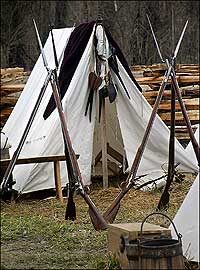
Conditions for soldiers, as miserable as they could be, were an improvement for some over the way they had lived as civilians.
Substantial numbers of troops were drawn from ethnic groups and immigrants, most notably the Irish and Germans. Combatants represented the states' religious denominations, including a few whose doctrines were pacifist.
There can be no perfect portrait of the Revolution's common soldier. But we can be certain that, whoever he was, the common soldier did, as Lincoln said, leave us "a history bearing the indubitable testimonies of its own authenticity, in the limbs mangled, in the scars of wounds received."
Of the men under arms in the Revolution, more than 25,500 perished in battle, or as prisoners, or from diseases in camp. More than 8,000 others survived serious wounds, and nearly 1,500 disappeared. Nearly one out of five of all soldiers were casualties—killed, wounded, or missing in action—the rate, about one of every three among the regulars of the Continental Army. The Union Army in the War between the States sustained about 13 percent casualties.
It may not be possible to perfectly describe the common Revolutionary soldier, but one thing is certain.
We remain in his debt.
Christopher Geist, professor emeritus at Ohio's Bowling Green State University, contributed an article on the occupation of Williamsburg to the spring 2004 journal.
Web Exclusives
Suggestions for further reading:
- James Kirby Martin and Mark Edward Lender, A Respectable Army: The Military Origins of the Republic, 1763-1789 (Arlington Heights, IL, 1982).
- Joseph Plumb Martin, Private Yankee Doodle, Being a Narrative of Some of the Adventures, Dangers and Sufferings of a Revolutionary Soldier, ed. George F. Scheer (Boston, 1962).
- Holly A. Mayer, "The Continental Army," in A Companion to the American Revolution, ed. Jack P. Greene and J. R. Pole (Malden, MA, 2000).
- Ray Raphael, A People's History of the American Revolution (New York, 2001).
- Charles Royster, A Revolutionary People at War (Chapel Hill, NC, 1979).
- John Shy, A People Numerous and Armed (New York, 1976).

